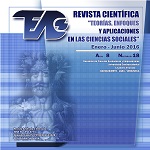Looseness of financial resources and its impact on the good practices of corporate social responsibility.
Keywords:
RSC, slack of resources, own equity slack, debt, corporate social performance, ETHOS indicatorsAbstract
This article aims to analyze the impact of clearance of funds measured by the ratio between debt and equity in the development of best practices Corporate Social Responsibility (CSR) of the SMEs in Zone 7 comprising the provinces Ecuador Loja, Zamora and El Oro. In this paper we analyze if the excess resources of the company allows it to generate CSR practices. It has generated an indicator that measures the CSR of SMEs through the ETHOS indicators applied to a sample of 124 companies and has also been used indicator of financial slack. Through regression analysis the impact of resource slack is analyzed from approaches equity - debt ratio and CSR. The results obtained in this investigation to prove that the financial clearance approach debt - equity has an impact on the good practices of CSR. So it could be concluded that SMEs in the Region 7 Ecuador interested in strengthening its CSR practices should focus their efforts to generate a surplus of resources from the perspective of the debt ratio - equity.
Downloads
References
Allouche, J., & Laroche, P. (2005). A meta-analytical investigation of the relationship between corporate social and financial performance.Revue de Gestion des Ressources Humaines, 57(1), 18-41. Asociación Española de Contabilidad y Administración de Empresas (2004): Marco Conceptual de la Responsabilidad Social Corporativa. Documentos AECA, Serie Responsabilidad Social Corporativa No 1.
Argilés-Bosch, Josep M. et al. 2014. "Empirical Analysis of the Incidence of Accidents in the Workplace on Firms’ Financial Performance." Safety Science 70: 123-32. Barnard, C. (1938). 1. 1938. The functions of the executive. Cambridge/Mass.
Bourgeois L. (1981). On the measurement of organizational slack. Acad Manage Rev;6:29- 39.
Bradley, Steven W., Dean A. Shepherd, and Johan Wiklund. (2011a) "The importance of slack for new organizations facing ‘tough’environments." Journal of Management Studies 48.5: 1071-1097.
Bradley, Steven W., Johan Wiklund, and Dean A. Shepherd. (2011b) "Swinging a double-edged sword: The effect of slack on entrepreneurial management and growth." Journal of Business Venturing 26.5: 537-554.
Charitoudi, G., Sariannidis, N. y Giannarakis, G. (2011). The development guide for corporate social responsibility programming. European Journal of Scientific Research, 65(1), 20-27.
Cyert, Richard M., and James G. March. (1963) "A behavioral theory of the firm." Englewood Cliffs, NJ 2. Dyer Jr., W.G., Whetten, D.A., (2006). Family firms and social responsibility: preliminary evidence from the S&P500. Entrep. Theory Pract. 30 (6), 785-802.
Ethos Instituto de Empresas e Responsabilidade Social. (2010). Indicadores Ethos de Responsabilidad Social Empresarial. Retrieved from www.ethos.org.br George, G. (2005), ‘‘Slack resources and the performance of privately held firms’’, Academy of Management Journal, Vol. 48 No. 4, pp. 661-76.
Herrera Madueño, Jesús, Manuel Larrán Jorge, María Paula Lechuga Sancho, and Domingo Martínez-Martínez. 2015. "Responsabilidad Social En Las Pymes: Análisis Exploratorio de Factores Explicativos" Revista de Contabilidad (xx). http://linkinghub.elsevier.com/retrieve/ pii/S1138489114000466.
Hirigoyen, Gerard, and Thierry Poulain-Rehm. 2015. "Relationships between Corporate Social Responsibility and Financial Performance: What Is the Causality?" Journal of Business and Management 4(1): 18-43. http://www.todayscience.org/jbmarticle.php?paper_ id=199500035.
Julian, Scott D., and Joseph Ofori-Dankwa. 2013. "FINANCIAL RESOURCE AVAILABILITY AND CORPORATE SOCIAL RESPONSIBILITY EXPENDITURES IN A SUB-SAHARAN ECONOMY :" Strategic Management Journalt 1330(July 2011): 1314" 30.
Nohria, Nitin, and Ranjay Gulati. (1996) "Is slack good or bad for innovation?." Academy of management Journal 39.5: 1245-1264.
Oba, Victor Chiedu, and Fodio Inuwa Musa. 2012. "Financial Slack and Upper Echelon Traits as Predictors of Corporate Philanthropy in Nigeria." International Journal of Business and Social Science 3(18): n/a. http://search. proquest.com/docview/1127896568?accountid=14338.
Orlitzky, Marc, Frank L. Schmidt, and Sara L. Rynes. 2003. "Corporate Social and Financial Performance: A Meta-Analysis." Organization Studies 24: 403-41. http:// oss.sagepub.com/content/24/3/403.abstract. Penrose, E. T. (1959). The Theory of the Growth of the Firm. New York: John Wiley.
Porter, Michael E., and Kramer, Mark R. (2006) "The link between competitive advantage and corporate social responsibility."Harvard business review 84.12: 78-92. Singal, Manisha. 2014. "Corporate Social Responsibility in the Hospitality and Tourism Industry: Do Family Control and Financial Condition Matter?" International Journal of Hospitality Management 36: 81-89. http://dx.doi. org/10.1016/j.ijhm.2013.08.002.
Thompson, J. D. (1967). Organizations in action: Social science bases of administrative theory. Transaction publishers.
Vanacker, Tom, Veroniek Collewaert, and Ine Paeleman. 2013. "The Relationship between Slack Resources and the Performance of Entrepreneurial Firms: The Role of Venture Capital and Angel Investors." Journal of Management Studies 50(6): 1070-96.
Voss, G. B., Sirdeshmukh, D., & Voss, Z. G. (2008). The effects of slack resources and environmental threat on product exploration and exploitation. Academy of Management Journal, 51(1), 147-164.
Waddock Sandra, and Samuel Graves. 1997. "The Corporate Social Performance- Financial Performance Link." 18(December 1994): 303-19.
Wood, Donna J. (1991) "Corporate social performance revisited."Academy of management review 16.4: 691- 718.
Zahra, S. A., Sapienza, H. J., & Davidsson, P. (2006). Entrepreneurship and dynamic capabilities: a review, model and research agenda. Journal of Management studies, 43(4), 917-955
Published
How to Cite
Issue
Section
Derechos del/de autor/es a partir del año de publicación
Esta obra está bajo la licencia:
Creative Commons Reconocimiento-NoComercial-CompartirIgual 4.0 Internacional (CC BY-NC-SA 4.0)
Las opiniones expresadas por los autores no necesariamente reflejan la postura del editor de la publicación ni de la UCLA. Se autoriza la reproducción total o parcial de los textos aquí publicados, siempre y cuando se cite la fuente completa y la dirección electrónica de esta revista. Los autores(as) tienen el derecho de utilizar sus artículos para cualquier propósito siempre y cuando se realice sin fines de lucro. Los autores(as) pueden publicar en internet o cualquier otro medio la versión final aprobada de su trabajo, luego que esta ha sido publicada en esta revista.



